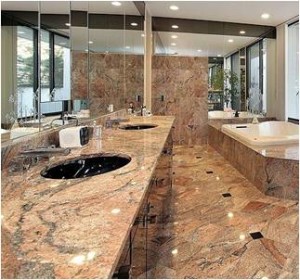 Because marble is part of the limestone family, it is composed of mostly calcium carbonate.
Because marble is part of the limestone family, it is composed of mostly calcium carbonate.
Calcium carbonate is also found in familiar materials like pearls, shells and even teeth and bones.
As such, it is sensitive to solutions that are acidic and can etch the surface if not properly cared for.
Here are 10 Tips to consider in cleaning a marble floor that will keep your floor’s luster for years of enjoyment and use.
- Use a dry, clean (not treated with a cleaning or polishing spray) dust mop type sweeper regularly to remove surface dirt left by shoes, slippers, rugs, pets or just plain air circulation in your home or business. Any grit left on the surface of a marble floor will etch the surface causing your floor to lose its shine where etched.
- Do not use man-made cleaners designated for use on ceramic tile on your marble floors. Because marble is natural stone thinking a ceramic tile cleaner will work may actually damage your marble. Ceramic-type kitchen and bathroom cleaners can dull, stain and even damage stone.
- Because marble has a calcium carbonate component, any acids – even a mild solution of vinegar and water which works well for just about everything else – will etch the surface of marble flooring over time.
- Only cleaners that are concentrated with a neutral pH and acid-free should be used.
- In the absence of a neutral pH cleaner, marble flooring can be mopped with just warm water. To keep the floor streak-free, the warm water should be changed frequented and then the floor dried with a clean, untreated soft cloth rather than letting the floor “air dry”. This will help maintain its shiny finish.
- Marble floors can be protected by remembering to add matting or some other felt or non-abrasive barrier between plants, light floor fixtures, cabinets, trash receptacles, hall trees, coat racks or anything else coming directly in contact with your floor.
- Do not use any scouring powders, creams or alkaline products as these contain small abrasive particles that can scratch your marble floor surface.
- Unsealed marble is more susceptible to staining because marble is a porous material. If your marble floor is unsealed and after you clean it, consider adding a penetrating sealer recommended for use on untreated marble. Based on the level of traffic your floor gets and on the manufacturer’s warranty of the sealer, this can extend the life and appearance while reducing your floor maintenance over time. See how to test your marble to see if it’s sealed HERE.
- Don’t use a vacuum cleaner, hand-held, canister or upright on a marble floor. The wheels as well as the plastic or metal materials in a hose or nozzle can scratch the surface of the marble.
- Using walk-off mats or rugs outside an entry to your marble floor can collect a lot of the grit or abrasive materials that might other end up on the floor. Be cautious of throw rugs placed on a marble floor because not only could there be a chemical reaction between the rug backing which may discolor the marble but depending on the backing material, this could also scratch the floor’s surface as any abrasive leach through the rug.
Marble floor cleaning can be as easy as clean water, a dry mop and a little diligence in incorporating the above considerations into a periodic maintenance routine.
While a lot of this applies to newer flooring, steps for removing old waxy buildups or etching on older floors can be accomplished by rebuffing the entire surface and may be best handled, in the instance of moderate damage, by a professional.




